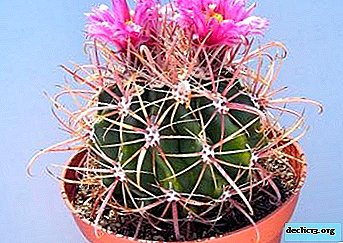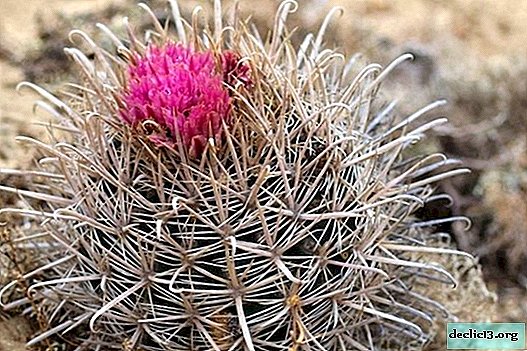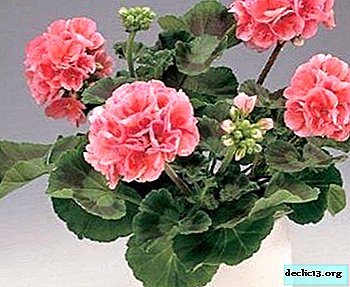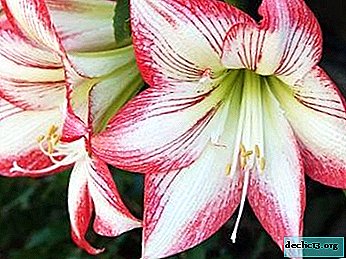An unusual popular plant is ferocactus. Description of its species and their photos, rules for care

Ferocactus got its name from the Latin "ferus". When translated into Russian, this word means "hard", "wild". Ferocactus belongs to the perennial cactus family.
Among the variety of indoor flowers, ferocactus is very popular.
These plants do not need special care. They stand out for their unusual appearance and beautiful flowering. In the article, we will consider in detail each type of ferocactus.
Popular types and varieties of ferocactus, their photo
This desert rounded plant loves warmth (about cacti growing in deserts, read here). It tolerates hot and dry climates. It is not affected in any way by the long absence of water. Distinctive features of different species of this plant are ribs:
- direct;
- thick ones;
- deeply cut.
Spines in ferocactus are long, powerful and brightly colored. There are hook-shaped spines, as well as round or flat from the base. Another feature is the presence of large and fluffy areoles, which, unlike other cacti, are not combined at the top into a fluffy hat (learn about fluffy cacti in this material). At home, you can grow different types of ferocactus.
Emory (Emoryi)

This type of plant has a stalk of dark green color of spherical shape. Over time, it stretches, reaching a 2-meter height. Its vertical ribs of embossed shape are narrowed. There are from 22 to 30 pieces. The thorns are rather thick and long, slightly curved. They can be red, pink or white. The plant blooms with pinkish-yellow flowers that appear on the top of the stem. In diameter, the flowers are from 4-6 cm. After them, long 3-5 cm yellow ovoid fruits remain.
Latispinus

This view is one of the most amazing. Its green-blue stalk, which has a spherical shape, grows in diameter up to 35-40 cm. Large flowers of pink color are similar to bells (you can learn more about pink cacti here). For the shape of the spines, Latispinus is called the damn language. His large needles grow up to 2 cm, are painted in white and pink.
Bluish (Glaucescens)

Ferocactus Glaucescens trunk:
- bluish green;
- large;
- velvety.
At a young age, it is spherical, but eventually becomes cylindrical. He almost always has 13 ribs, they are hilly and long. Areoles have a grayish-white color; from 6 to 8 radial spines are located on them, which are slightly spread out (are there cacti without spines?). There is also one central powerful. All of them are light yellow, reach a length of 2-3 cm. Yellow flowers of a puffy Ferocactus, petals elongated. They appear on an old plant from its woolly crown.
Hystrix

Young porcupine Ferocactus Hystrix has spherical stems, the old - barrel-shaped. This type of ferocactus has many variations and shapes. They differ in the number of spines. Many of the Hystrix ferocactus do not like the strong midday sun in the spring and summer.
Its round green with a bluish stem has a velvety skin. The plant grows to a height of 50-70 cm. It has strictly vertical tall and wide ribs covered with infrequent areoles, thin needles of a yellowish or whitish hue. In the middle are 2-3 pieces of 6 centimeter yellowish-red processes. Spines grow 2-3 cm long.
Flowers with a bell shaped belllocated on top of the stem. Looking at them, it seems that they are lying on a pillow of pile. Fruits of yellow color, growing up to 2 cm in length, are edible, their pulp contains black seeds.
Hairy (Stainesii)

This type of ferocactus is first spherical, and then cylindrical in shape, painted in dark green. The ribs are quite high, the radial spines reach a length of 2 cm. The central 4 centimeter spines are most often hook-shaped and flat. All of them have an orange or reddish tint. Areoles of Ferocactus Stainesii pubescent. Adult plants bloom in orange or yellow bell-shaped flowers.
Wislizeni (Wislizeni)

Ferocactus Vistula is distinguished by its considerable size. Its trunk can grow up to 2 m high. It has a round or teardrop shape. On the stem are high relief ribs, there may be 25. Areoles are rare, there are bundles of brown spines in them. Each has straight and thin needles, as well as one or two twisted greasy. The plant blooms in red or yellow flowers, the diameter of which is 5 cm (read about cacti with red flowers here). They can see a tube in the shape of a wreath in the middle. After they fade, oblong 3-5 cm yellow fruits appear.
Horridus

The Khorridus cultivar has a dark green stem, which is colored yellow at the base. It has a cylindrical or spherical shape. This type of ferocactus can grow up to 1 m high and 30 cm wide. It has somewhat winding ribs that cover short and sparse spines. Straight white needles are radially located, and in the middle are thick hooked red or burgundy long growths.
Ford (Fordii)

The Ford ferocactus cultivar has a rounded spherical stem and 20 ribs. There are 15 light pale radial spines, in the center they are red-gray in color and have a hook shape. The flowers of this type of plant are purple.
Powerful (Robustus)

Ferocactus potent is the most widely growing variety. Its height is 1 m, and its diameter is 5 m. The stem of dark green color has 8 ribs, and spines:
- reddish brown
- various lengths;
- flat shape.
Small flowers are painted bright yellow.
Rectospinus (Rectispinus)

The stem shape of the straight-throated ferocactus is cylindrical. In height, it can grow up to 1 m, and in diameter - 30-35 cm. The presence of the longest spines in this variety made this ferocactus popular for breeding at home. The needles reach a length of 20-25 cm, along the entire length they are painted brown-yellow, and the tips are pink. Blossom with yellow flowers.
Plant Care Rules
Ferocactus will feel best on window sills, which the sun's rays penetrate all day. In the summer, it can be taken out to fresh air, providing protection against rain. In winter, a bright room is suitable, where the temperature is plus 8-10 degrees. With a sharp decrease in it, cracks and brown peels appear on the stem.
In the cold months, it is watered quite rarely and always with warm water. From spring to October, the plant should be regularly watered. But it is impossible for the water to stagnate. In hot weather, it is advised to spray the plant with warm water, this is done in the morning and evening. In late spring and until mid-summer, you need to feed with special fertilizer.
Important! Adult ferocactus is transplanted once every 2-4 years in the spring, and young - every year. In this plant, during its growth from the thorns, sugar syrup is released. When it freezes, crystals form, which must be washed off gently using a brush dipped in alcohol, or simply removed.At home, Ferocactus has an extensive range of applications. Animals feed on its flesh. Many types are raw materials for the production of sweets and flavors. Florists fell in love with ferocacti for their decorative qualities.

















